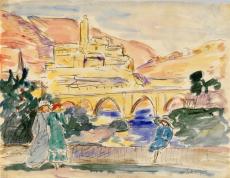


Despite having briefly frequented the studio of Léon Bonnat (1833-1922) at the École des Beaux-Arts in Paris, Henri Lebasque freed himself of his academic training when, while showing his work at the Salon des Indépendants of 1893, he met Paul Signac (1863-1935) and Maximilien Luce (1858-1941). However, he did not become a Neo- Impressionist. Instead, he elaborated a colourful and sensuous style of painting, which was influenced by Impressionism but with touches of Fauvism. Painting almost any subject, though attracted primarily to the human figure and the nude, like Pierre Bonnard (1867-1947), Lebasque spent his entire career as a traveller in search of new motifs. A founding member of the Salon d’Automne, where he frequently exhibited his work, he represents a muchloved figurative tradition that was often expressed in decorative schemes, most notably for passenger ships and the Théâtre des Champs-Elysées in Paris, in 1912. Having held his first solo exhibition at the Galerie Georges Petit in 1906, he soon attracted the attention of several collectors, among them the influential Count Isaac de Camondo (1851-1911; whose collections are now divided amongst the Louvre, the Musée d’Orsay and the Musée National des Arts Asiatiques Guimet in Paris).
Lebasque’s contemporaries admired the quality of his watercolours, about which Adolphe Tabarant wrote in 1926: ‘Lebasque brings to his watercolours the resources of his gracious and smiling art, concealing its strength under the semblance of an improvised execution. But the freedom and boldness of his brush loaded with coloured water, completing with large, vivid brushstrokes or broad gashes a minimal yet sure line, and the accuracy of the values which make up for the minutiae of the eliminated detail, have generated, throughout his career, such brilliant notations that they amount to complete works, while keeping the flavour of spontaneity.’1 Although the landscape depicted in Jeunes Femmes dans un Paysage Provençal suggests the Mediterranean Midi, the exact location is not identified. The handwritten notes concerning the colours certainly characterise the painting as a work-in-progress, but we do not know which painting it turned out to be. The date also remains uncertain, even though we could propose placing this watercolour around 1925-1930.
Having dismissed his academic training as a painter, he fused his own colourful style, combining elements of Impressionism and Fauvism. He created works with a calm, intimate feeling, often featuring women and children in an interior or garden setting or at the seaside. He was a founder of the Salon d’Automne, an accomplished watercolourist and a painter of figurative decorative schemes for ships and the theatre.